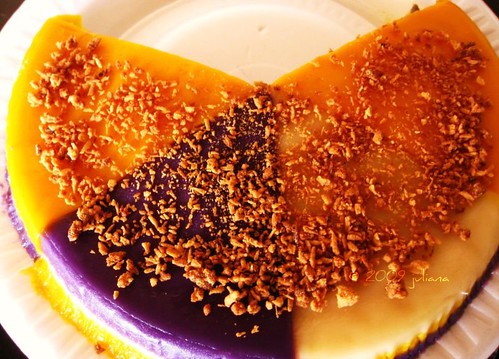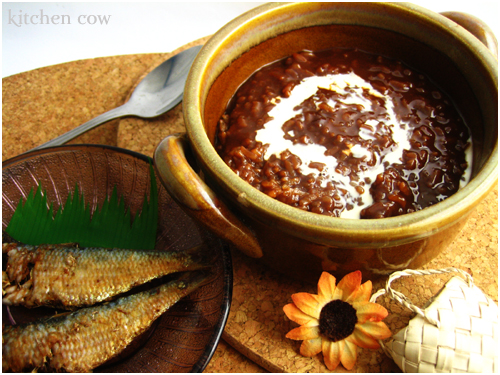By Sigrid Salucop
Filipino pastries may be simple but they sure are tasty.
While many Filipinos crave for western pastries and cakes, there are those
times when you just want a simple, gluten-free dessert i.e. puto or kutsinta or
even both! Gluten-free or not, here are the best pinoy pastries and desserts that
you can easily make.
Leche Flan
 |
| This is what one usually feels when one eats a flan - <3 (heart/love) |
The Flan is a dieter’s worst nightmare. It’s smooth, creamy
and sugary goodness is just something one can’t resist. Although the name is
very Spanish and even if it can be traced both to Spain and France –the origin
of those uber yummy crème brulee and crème caramel, we have made this recipe
our own. This dessert is usually served during special occasions. Oh yes…there’s
definitely nothing leche about this flan.
Puto
Want cake but don’t want anything that’s too heavy? Get a puto.
Also known as rice muffins, this recipe is also available in other Asian countries but
the Philippine version is much sweeter –probably because Filipinos love sweets more than their neighbors.
 |
| Puto Calasiao is deemed as the best authentic Philippine puto. |
However, if you are in a Spanish-speaking country and you happen to
cook some puto, better not say, “Have some puto, Puto!”
Puto is usually
accompanied by shredded coconut or topped with butter or cheese. The Tagalog however
eat puto with dinuguan which is yum for many and disgusting for some –all about
taste really.
Puto has a lot of versions but one of the loveliest is the Puto Pao. If you want dry puto, you can have the Castilian Puto Seco.
Kutsinta
Kutsinta for your sinisinta may not be a very good
catchphrase for this Philippine pastry but it still is as yummy as other
pastries around. This steamed, brown rice cake has an interesting story to tell
though.
Back in the year 1942, a woman by the name of Cita was hankering for
freshly cooked rice. Her boyfriend Kulas, a rice farmer, decided to cook some
for her but instead of adding a bit of salt to taste, he put in brown sugar and
even put in too much water.
With so many things to do at the farm, Kulas left
the pot on the stove for too long, not even realizing the mistake he has made.
When he came back, he found that he has made a sweet, pasty rice cake. He found
it rather appetizing and decided to bring it to Cita. Cita of course loved the
finished product and gave some to the people in their barrio. They named the
pastry after themselves.
Bibingka
This rice pudding is definitely Filipino but the recipe
itself has a striking resemblance to bebinca, a pudding originating from Goa.
The pudding from Goa however does not have rice in it but it has coconut milk
much like the traditional bibingka in the Philippines.
According to several
historians, the word “bi” is Chinese for rice, no one knows where the other
letters come from (yes they come from the alphabet you smart ass!) and what
they mean though.
Whatever bibingka’s history, let’s crank up the volume of the
stereo and listen to Sharon Cuneta’s Maging Sino Ka Man while eating this
Philippine rice pudding.
Ube Halaya
Many find purple yam odd because it’s err… purple. Although
it is a good dessert in itself i.e. boiled and dipped in sugar, it becomes a lot
better when it is made into a pan of creamy Ube Halaya.
Sapin-Sapin
Made from either rice flour or rice soaked overnight, this
Philippine pastry traces its origins to the northern part of the country. Sapin-Sapin is more like a stickier and rather creamy version of the kutsinta.
Maja Blanca
This coconut pudding is a Spanish dessert based on manjar
blanco. Although this white delicacy can be served plain, many Filipinos add
corn kernels to it making the usual maja blanca into maja blanca con maiz.
If you are tired of the usual maja blanca, adding squash is
also a great idea.
Pichi-Pichi
This Philippine dessert made from sugar, cassava, and
coconut with a hint of pandan is basically a soft puto. It is a favorite
dessert from the province of Quezon. It is however also sold in other Philippine provinces.
Polvoron
Simple yet delectable, polvoron is a powdery Philippine
dessert based on Spanish shortbread cookies. Polvoron mixed with ground nuts is
also used as the main ingredient in another Philippine delicacy –Turones de
Mani.
There are now shops that sell Polvoron cupcakes in an effort to reinvent this very simple dessert.
Macapuno
Formerly a mutant of the coconut tree, the Philippine
Coconut Authority successfully developed trees that yield 80% macapuno fruits making the macapuno another puno –yay
to that yeah? Macapuno looks like the usual coconut but inside, it is filled
with a yummy jelly.
Due to its economic value, the Philippine government encourages farmers to grow more of these trees. Now let’s move to the
dessert. Usually paired with ube or spread on top of a pan of crème caramel, the
shredded macapuno we see is a preserved version of the fruit. It is full of
sugary goodness and of course the unmistakable…err… macapuno flavor. It is also made into candies like the ones in the photo.
Brazo de Mercedes
Brazo de Mercedes is a light and very delicate cake roll.
Although the name is Spanish sounding, this jelly roll is more popularly known in
the west as the Swiss roll.
However, one has to note that the Philippine
version is a lot lighter since no flour is used.
Ginataan
Described by many a Filipino children as the hot version of
the uber popular halo-halo, Ginataan is served during the rainy season or for
Filipinos living abroad, during wintertime.
This Philippine dessert is known by
many names, it is referred to as the alpahor in Chavacano, ginat-taan in
Ilocano and tinunuan in Cebuano. It is also called bilo-bilo in some parts of
the country. Whatever it’s called though, this dessert cooked in coconut milk
is an all-time favorite among Filipinos.
No one is sure where the Ginataan originated from though but let's just keep eating it and hope that the answer will materialize at one point.
Champorado
Love chocolate? If you need carbs and you want chocolate
with it, champorado is your best bet. Usually served for breakfast, this
Philippine porridge can still be served for dessert or as one meal for someone
craving for something sweet. Champorado is of Mexican origin but the original doesn’t
have rice in it.
Palitaw
Made from sticky rice, Palitaw is another version of the
Philippine rice cake. It is however usually served with sesame seeds. In some
versions, the palitaw is topped with grated coconut. You can put both sesame seeds and grated coconut though like the one in the photo.
Napoleones
Most Filipinos would associate Bacolod City with the piyaya
and the inasal but there is this one wonderful recipe from this beautiful city
that is rather mouthwatering. It is called Napoleones and yes, according to
some historians, the recipe probably came from Naples. Layered with custard cream and
topped with white sugar, this puff pastry is to die for.
Bitsu-Bitsu
Bitsu-Bitsu and its twisted version the pilipit can be
safely called as the Philippine version of a doughnut. It is fluffier than a
churro, softer than a pretzel, and usually served sprinkled with granulated
sugar –the result – Y. U. M. YUM!
Buko Pie
“Buko Pie, Buko Pie
kayo diyan! Bagong luto!” Sure you always hear this inside busses coming
from the southern part of Luzon. In fact, Filipinos are so used to it that
many fail to realize how tasty this dessert is.
Alpajo
Remember the alpahor of the Chavacanos? Well this Ilocano recipe
is nothing like it. The alpahor is ginataan but the Alpajo is a soft candy made
from coconut, milk, and sugar. It's not sold anywhere though but some homes in the north still make them. My grandmother makes them every Christmas -they are oh so tasty!
Espasol
This dessert was described by a friend as something that tastes like dirt and ash but tasty -yes, tasty.
Espasol is made from rice flour and coconut milk. It is dusted with toasted rice flour once it is shaped into the cylindrical shape Filipinos are so familiar with.
Other Pinoy desserts that are also rather tasty include suman latik, tupig, and calamay.
Photos via
cmthm1t1.bloggspot.com
prepys.com
pinoyadventurista.com
julianasworld.com
365pinoystuff.wordpress.com
filipinodesserts.net
marketmanila.com
chyngreyes.com
kitchencow.com
Dindin Lagdameo
pinoycookingrecipes.com
anjasfood4thought.com
applesaute.blogspot.com
















I don't know which of these looks tastiest. I'll have try them all.
ReplyDeleteis this the best desserts in Manila?? i'm excited to go here
ReplyDelete